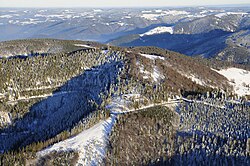Schauinsland
| Schauinsland | |
|---|---|

Schauinsland, 2007
|
|
| Highest point | |
| Elevation | 1,284 m (4,213 ft) |
| Coordinates | 47°54′40″N 7°53′58″E / 47.91111°N 7.89944°ECoordinates: 47°54′40″N 7°53′58″E / 47.91111°N 7.89944°E |
| Naming | |
| Translation | Look into the country (German) |
| Geography | |
| Location | Baden-Württemberg, Germany |
| Parent range | Black Forest |
The Schauinsland (literally "look-into-the-country"; near Freiburg im Breisgau, Germany), is a mountain in the Black Forest with an elevation of 1,284 m (4,213 ft) above sea level. It is a popular destination for day trips. Due to the high amount of silver mining, it was previously known as “Erzkasten” (literally “ore box”); the name “Schouwesland” first appeared in 1347. The mountain is located roughly ten kilometres south-east of Freiburg’s city centre.
The summit of the Schauinsland is located in the district of Freiburg. The mountain is surrounded by towns such as Oberried, Munstertal, Bollschweil, and Horben (clockwise). The closest village to the summit is Hofsgrund. In Autumn especially, during a temperature inversion, there is a clear view of the Vosges mountains from the top of the Schauinsland. Under appropriate weather conditions there is a view of a large portion of the Swiss Alps.
Since 2003, the Holzschlägermatte on the Schauinsland has been home to a number of very controversial wind turbines. Due to conservation issues (the summit of the Schauinsland is part of a nature reserve), they were constructed at an elevation of roughly 1,000 m above sea level instead of on the summit. Therefore, the view to and from the summit is only slightly restricted. During the lawsuit against the operating company, the Freiburg-based artist Richard Schindler wrote an expert report which is considered the first of its kind.
For over 700 years, silver, lead and zinc were mined from the Schauinsland. In the Middle Ages, mining was very productive, so much so that in the 14th century a number of contractors of the Dieselmuot mine could afford to donate glass windows to the Freiburg Minster. The miners lived right next to the mines on the Schauinsland in two settlements, which were abandoned during the 16th century. The silver obtained was traded and used for minting coins. The mining tunnels are spread over 22 levels and amount to a total of about 100 kilometers. At the beginning of the 20th century, about 250 miners were employed in the Schauinsland mines. Production ceased in 1954 due to the mine not yielding enough economy.
...
Wikipedia

